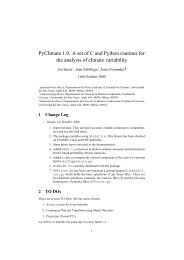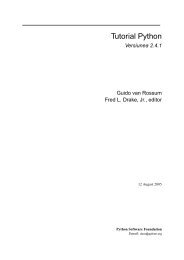3.2 netCDF filesTo access netCDF files, pyclimate uses <strong>the</strong> excellent netCDF package in K. Hinsen’sScientific <strong>Python</strong>. Two special functions have been built on top <strong>of</strong> K. Hinsen’s interfaceto make <strong>the</strong> use <strong>of</strong> structured netCDF files easier, <strong>and</strong> <strong>the</strong>y are included in <strong>the</strong> filencstruct.py.Function: def nccopystruct(name,inc,dims,vars,varcontents)This function replicates <strong>the</strong> structure <strong>of</strong> a Conventions–compliant netCDF file (seeCOARDS conventions http://www.unidata.ucar.edu). These conventionsusually imply <strong>the</strong> definition <strong>of</strong> a <strong>set</strong> <strong>of</strong> variables like latitude, longitude or vertical level<strong>and</strong> some auxiliary attributes like units or <strong>the</strong> numbers assigned to <strong>the</strong> missing valuesor scale <strong>and</strong> <strong>of</strong>f<strong>set</strong> values <strong>for</strong> packing. This function helps in <strong>the</strong> creation <strong>of</strong> structuredoutput files from an input data<strong>set</strong> without having to individually copy ALL <strong>of</strong> <strong>the</strong> globalattributes, auxiliary variables <strong>and</strong> <strong>the</strong>ir attributes. In case a history attribute existed,it is updated with <strong>the</strong> date <strong>and</strong> <strong>the</strong> name <strong>and</strong> arguments <strong>of</strong> <strong>the</strong> calling program. Thefunction returns a netCDF file object ready to be used. This function opens <strong>the</strong> existingnetCDF file with <strong>the</strong> ’w’ flag, overwriting any existing file with <strong>the</strong> same name. Parametername is <strong>the</strong> name <strong>of</strong> <strong>the</strong> output datafile to be created. inc is <strong>the</strong> input NetCDFfile whose structure is to be replicated. dims is a sequence <strong>of</strong> dimensions <strong>of</strong> <strong>the</strong> inputdatafile which are to be copied onto <strong>the</strong> output datafile. vars is a sequence <strong>of</strong> variablesto be copied onto <strong>the</strong> output datafile without copying <strong>the</strong> contents, just <strong>the</strong> declaration,type, structure <strong>and</strong> comments. varcontents is a sequence <strong>of</strong> variables in <strong>the</strong> parametervars whose structure <strong>and</strong> contents are to be copied from <strong>the</strong> input data<strong>set</strong>. The functionexi<strong>of</strong>uncsnc.py shows examples <strong>of</strong> use <strong>of</strong> this function.Function: create bare COARDS(ncname, tdat=None, zdat=None, latdat=None,londat=None)This function creates a bare–minimum COARDS–compliant netCDF file. ncname is<strong>the</strong> name <strong>of</strong> <strong>the</strong> output file that is being created. tdat is None or a tuple with first element<strong>the</strong> NumPy array <strong>of</strong> items to be held (None <strong>for</strong> a record variable) <strong>and</strong> with secondelement in <strong>the</strong> tuple <strong>the</strong> units attribute <strong>of</strong> <strong>the</strong> created time variable. If tdat is None, notime variable nor dimension will be created. zdat is a tuple with two elements. Thefirst one is <strong>the</strong> NumPy array <strong>of</strong> vertical levels. The second one is <strong>the</strong> units attribute<strong>of</strong> <strong>the</strong> vertical levels. If zdata is None, no vertical dimension is created. latdat is aNumPy array <strong>of</strong> latitudes. The units attribute is alwasy <strong>set</strong> to “degrees north”. If thisparameter is None, no latitudinal dimension is created. londat is a NumPy array <strong>of</strong>longitudes. The units attribute is <strong>set</strong> to “degrees east”. If this parameter is None, nozonal dimension is created.4 Time h<strong>and</strong>ling <strong>routines</strong>One <strong>of</strong> <strong>the</strong> problems that researchers in climate analysis are usually faced to is <strong>the</strong>need to position <strong>the</strong>ir observations accurately in time. The file JDTime.py providessome functions to face this problem. It does not intend to provide a complete <strong>set</strong> <strong>of</strong>date h<strong>and</strong>ling <strong>routines</strong>. In particular, all <strong>the</strong> computations asume UTC time–zone <strong>and</strong>no DST functions are included (M.A. Lemburg’s mxDate provides some <strong>of</strong> <strong>the</strong>se extrafeatures). JDTime.py allows fast, accurate <strong>and</strong> easy date processing from <strong>Python</strong>without <strong>the</strong> need <strong>of</strong> extra packages. A very interesting feature is <strong>the</strong> possibility <strong>of</strong> easilyusing monthly intervals by means <strong>of</strong> <strong>the</strong> function monthlystep(), computed from<strong>the</strong> definition <strong>of</strong> a tropical year with <strong>the</strong> same value used in Unidata’s udunits.dat,6
so that <strong>the</strong> time values created this way can be correctly read <strong>and</strong> interpreted by <strong>the</strong>SDF interface in plotting programs as GrADS. The date arithmetic is carried out bymeans <strong>of</strong> Julian Days stored as double precision (Float64) numbers. Conversion functionsto date structures are provided by means <strong>of</strong> a C extension based on astronomicalalgorithms [6]. The file exjdtime.py provides some examples <strong>of</strong> <strong>the</strong> use <strong>of</strong> <strong>the</strong>sefunctions. The algorithm does not support dates be<strong>for</strong>e <strong>the</strong> start <strong>of</strong> <strong>the</strong> Gregorian calendar(1582-10-15). In particular, this means that you can not properly recover datesfrom some <strong>of</strong> <strong>the</strong> NCEP Reanalysis netCDF files, which start at 1–1–1, a date not includedin <strong>the</strong> Gregorian calendar.Class: JDTimeInteger members: year, month, day, hour, minute.Double member: second.The previous members can be directly accessed from <strong>Python</strong>.Function: def date2jd(jdt)From a JDTime structure jdt, get <strong>the</strong> Julian Day number as a double.Function: def jd2date(jd,jdt)Given a Julian Day jd, get <strong>the</strong> broken date structure jdt.Function: def monthlystep()Return <strong>the</strong> number <strong>of</strong> Julian Days in a month, that is, number <strong>of</strong> tropical days peryear (365.242198781) divided by twelve. This provides adequate accuracy <strong>for</strong> datesduring <strong>the</strong> instrumental part <strong>of</strong> <strong>the</strong> climate record. However, this approach poses aproblem because <strong>of</strong> <strong>the</strong> truncation problem that appears due to <strong>the</strong> different length <strong>of</strong><strong>the</strong> months. When using this approximation, some months are longer than o<strong>the</strong>rs <strong>and</strong>this means that one <strong>of</strong> <strong>the</strong> time steps may be in <strong>the</strong> first day <strong>of</strong> one month <strong>and</strong> <strong>the</strong> laststep on <strong>the</strong> last day <strong>of</strong> <strong>the</strong> same month (if month is longer than 30.43 days). To avoidthis truncation problem, <strong>the</strong> origin should be <strong>set</strong> to day 15th <strong>of</strong> <strong>the</strong> starting month. Thisway, <strong>for</strong> every record, <strong>the</strong> first two fields <strong>of</strong> <strong>the</strong> date structure (year <strong>and</strong> month) willbe adequately resolved by jd2date(). This can be easily explained with <strong>the</strong> nextexample, <strong>and</strong> its output.from pyclimate.JDTimeH<strong>and</strong>ler import *from pyclimate.JDTime import *a=JDTimeH<strong>and</strong>ler("hours since 1958-01-01")b=JDTimeH<strong>and</strong>ler("hours since 1958-01-15")mstep=monthlystep()*24print mstep," in hours = ",mstep/24.," days"print a.getdatefields(0.0,3)print b.getdatefields(0.0,3)print a.getdatefields(0.0+mstep,3)," Still in January"print b.getdatefields(0.0+mstep,3)," In February"730.484397562 in hours = 30.4368498984 days[1958, 1, 1][1958, 1, 15][1958, 1, 31] Still in January[1958, 2, 14] In FebruaryThere is a second file that allows <strong>the</strong> h<strong>and</strong>ling <strong>of</strong> COARDS compliant time variables innetCDF files, JDTimeH<strong>and</strong>ler.py.7









